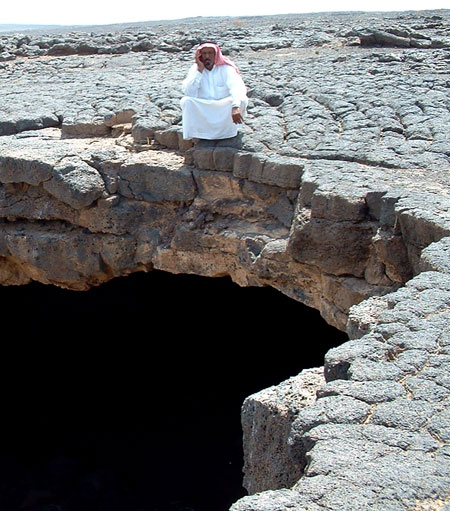 |
 |
VULCANOSPELEOLOGY IN SAUDI ARABIA by John J. Pint UIS Commission on Volcanic Caves Acta Carsologica 35/1, 107-119 Ljubljana, 2006 Four photographs, eight maps This article presents a brief
history of Vulcanospeleology in the Kingdom of Saudi Arabia and summarizes the
known studies carried out in Saudi lava caves. Some of these studies have been
published internationally or locally in Saudi Arabia. Others are alluded to in
non-scientific field trip reports on the Saudicaves web site (www.saudicaves.com).
Many other details remained in the field notes of the speleologists who visited
the caves, until the publication of this article. It is hoped that this summary
will assist researchers in ascertaining what is presently known about lava caves
in Saudi Arabia and may help to determine the nature and direction of future
vulcanospeleological studies on the Arabian Peninsula. (.PDF format,
1.71 megabytes)
VULCANOSPELEOLOGY IN SAUDI ARABIA - ABSTRACT
 Saudi Arabia has over
80,000 km2 of lava fields, locally known as harrats. However, only a few studies
of lava caves in Saudi Arabia have been published internationally. This article
summarizes the published and unpublished findings of all known expeditions to
lava caves in the kingdom. Prior to 2001, reports of such caves were mostly
limited to sightings of collapse holes by vulcanologists surveying the lava
fields. Few caves were entered and no cave maps were produced. In 2001 and 2002,
expeditions were organized to Harrat Kishb, located northeast of Makkah (Mecca).
Three lava caves measuring 22 m, 150 m and 320 m in length were surveyed and the
collapse features of a fourth cave—possibly over 3 km long—were studied. Two
throwing sticks, a plant-fiber rope and the remains of stone walls were found in
some of these caves. In 2003, lava tubes measuring 530 m and 208 m were surveyed
in Harrat Ithnayn and Harrat Khaybar, respectively. Animal bones and coprolites
were found in both caves. In 2003 and 2004, studies were carried out in Hibashi
Cave, located in Harrat Nawasif/Al Buqum, 245 km southeast of Makkah. The cave
was surveyed (length: 689.5 m) and found to contain two layers of burnt bat
guano overlying a bed of redeposited loess up to 1.5 meters deep and up to 5800
years old. At least 19 different minerals were found, three being extremely rare
organic compounds related to the guano combustion. Bones, horns, coprolites,
ruins of a wall and a human skull ca. 425 years old were also found. There is
evidence of many more lava caves in
Saudi Arabia,
particularly in Harrat Khaybar. Formal archeological and biological studies have
not yet been carried out in Saudi lava caves but may produce interesting
results.
Saudi Arabia has over
80,000 km2 of lava fields, locally known as harrats. However, only a few studies
of lava caves in Saudi Arabia have been published internationally. This article
summarizes the published and unpublished findings of all known expeditions to
lava caves in the kingdom. Prior to 2001, reports of such caves were mostly
limited to sightings of collapse holes by vulcanologists surveying the lava
fields. Few caves were entered and no cave maps were produced. In 2001 and 2002,
expeditions were organized to Harrat Kishb, located northeast of Makkah (Mecca).
Three lava caves measuring 22 m, 150 m and 320 m in length were surveyed and the
collapse features of a fourth cave—possibly over 3 km long—were studied. Two
throwing sticks, a plant-fiber rope and the remains of stone walls were found in
some of these caves. In 2003, lava tubes measuring 530 m and 208 m were surveyed
in Harrat Ithnayn and Harrat Khaybar, respectively. Animal bones and coprolites
were found in both caves. In 2003 and 2004, studies were carried out in Hibashi
Cave, located in Harrat Nawasif/Al Buqum, 245 km southeast of Makkah. The cave
was surveyed (length: 689.5 m) and found to contain two layers of burnt bat
guano overlying a bed of redeposited loess up to 1.5 meters deep and up to 5800
years old. At least 19 different minerals were found, three being extremely rare
organic compounds related to the guano combustion. Bones, horns, coprolites,
ruins of a wall and a human skull ca. 425 years old were also found. There is
evidence of many more lava caves in
Saudi Arabia,
particularly in Harrat Khaybar. Formal archeological and biological studies have
not yet been carried out in Saudi lava caves but may produce interesting
results.